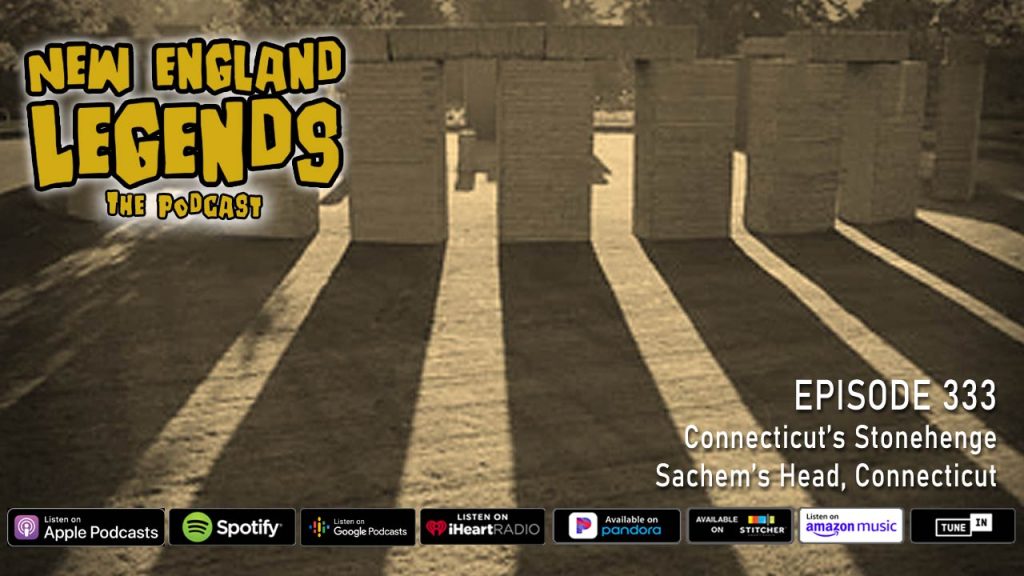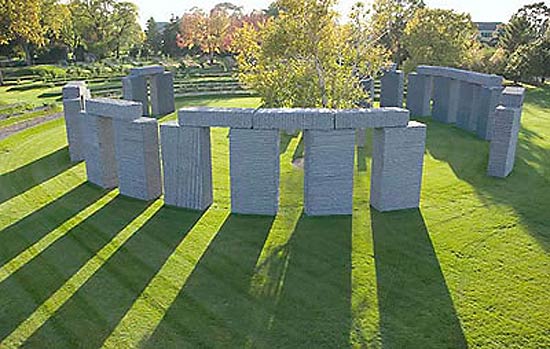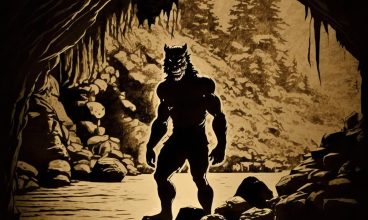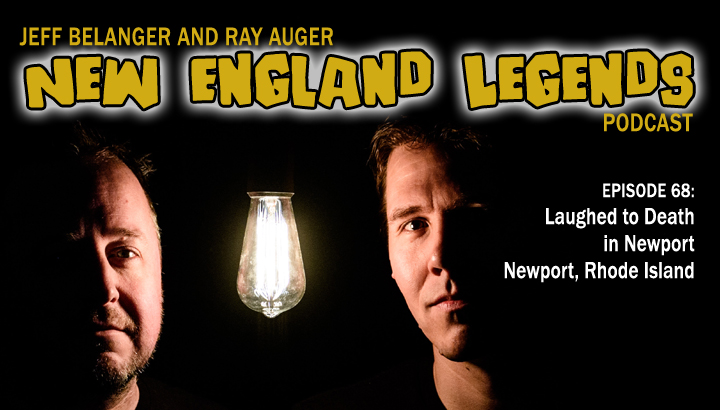
In Episode 333 Jeff Belanger and Ray Auger explore the shores of Sachem’s Head, Connecticut, to search for a not-so-ancient structure called “Circle of Life,” a monument that looks exactly like one of the Seven Wonders of the World: Stonehenge. But this monument was never supposed to be here. Who placed it… and why?
BECOME A LEGENDARY PATRON:
https://www.patreon.com/NewEnglandLegends
CREDITS:
Produced and hosted by: Jeff Belanger and Ray Auger
Edited by: Ray Auger
Theme Music by: John Judd
SUBSCRIBE TO THE PODCAST FOR FREE:
Apple Podcasts/iTunes | Google Podcasts | Spotify | Pandora | Amazon Podcasts | TuneIn | iHeartRadio
JOIN OUR SUPER-SECRET:
New England Legends Facebook Group

The Circle of Life – Stonehenge sculpture in Sachem’s Head, Connecticut.
EPISODE TRANSCRIPT:
*A note on the text: Please forgive punctuation, spelling, and grammar mistakes. Like us, the transcripts ain’t perfect.
[DRUIDS CHANTING]
RAY: This is freaky Jeff.
JEFF: Yeah it is. Like some kind of strange ritual going on here.
RAY: There’s robed figures holding torches. Some strange stone monuments over there… are we sure we’re in Connecticut and not some ancient site in Europe?
JEFF: I can see the confusion, Ray. This monument is a replica of England’s most famous ancient site. Its measurements and alignment are precisely set. And though this Guilford, Connecticut, site is nowhere near as old as the one in England, and nowhere near as old as either of us for that matter, it’s an enigma with quite a story behind it.
RAY: I can only imagine.
JEFF: We’ve come to Guilford, Connecticut, to learn the secret origins of a monument called “Circle of Life,” a monument built to not only thumb the nose at some locals, but one that’s also a replica of… Stonehenge.
[INTRO]
JEFF: I’m Jeff Belanger.
RAY: And I’m Ray Auger. Welcome to Episode 333 of the New England Legends podcast. Thanks for joining us on our mission to chronicle every legend in New England one story at a time. From roadside oddities, to ghosts, monsters, UFOs, true crime, and the just plain weird, we cover it all. And we can’t find these stories without your help, so please reach out to us anytime through our Web site with your own strange local tales.
JEFF: We’ll uncover the mysteries of this Connecticut Stonehenge right after this quick word from our sponsor.
SPONSOR
RAY: Okay, Jeff. So we’re standing on the side of Uncas Point Road in the Sachem Head section of Guilford, Connecticut.
JEFF: Right.
RAY: I’m looking through a gate across a field to what looks like… well… Stonehenge!
JEFF: We are. We should point out that this site is on private property so you can only see it from the side of the road.
RAY: Right. Got it. So Stonehenge… the one in England… is considered one of the Seven Wonders of the World.
JEFF: It is! I had the chance to visit Stonehenge a few years ago in Salisbury, England. I was speaking at an event in the UK and we had a free day so some of us drove down to Stonehenge.
RAY: What was that like?
JEFF: We’re driving along the A303 and all of a sudden there it is on the top of a grassy hill. We’ve all seen it so many times on TV and in photos that there’s no confusion as to where you are. So we park the car, pay the admission fee which is 23 pounds or just about $30 dollars for one adult. And we walk up to the site. You’re only allowed to get so close. They don’t generally allow you to walk inside the stone circle without special permission.
RAY: Otherwise, it would be covered in stickers and tags from punks.
JEFF: Probably.
RAY: So I looked this up. The oldest section of Stonehenge dates back almost 5000 years! The outer ring consists of vertical sarsen standing stones about 13 feet high and seven feet wide and weighing 25 tons each. Stonehenge is also a burial site. There are many burial mounds around the grounds, and it’s believed these giant stones were an ancient calendar. A solar calendar that would have been calibrated each Winter Solstice so ancient people could track all 365 and one-quarter days of the year.
JEFF: When you see the site in person, it’s pretty amazing. Of course you wonder how people 5,000 years ago could build something like that. But also, Stonehenge is so famous you can’t help but be a little star struck. Kind of like if your favorite A-list celebrity walked into the bar where you’re hanging out.
RAY: I get that. But this version of Stonehenge here in Guilford, Connecticut, isn’t nearly that old.
JEFF: Nope. Not even close. And what’s here right now wasn’t even supposed to be Stonehenge. It should have been something else entirely. You might even make the argument that the Stonehenge that’s here now is a bit of a middle finger to some locals.
RAY: To find out how it got here, let’s head back to the year 2003.
[TRANSITION]
RAY: It’s the summer of 2003. “Crazy in Love” by Beyonce is the number one song on the radio, George W. Bush is president, and the war in Iraq is just a few months old. But here in the swanky Sachem’s Head section of Guilford, Connecticut, one local homeowner is optimistic. He’s looking to the stars.
JEFF: Sachem’s Head IS swanky. There’s some expensive waterfront real estate around here. But the moniker of the area takes its name from some brutal history. Back in 1637 there was a skirmish between the Mohegan Indians who were allied with the English and the Pequots. The battle happened in what is now called Bloody Cove Beach just about a half a mile to our southeast. After the battle, a Pequot sachem… or chief was beheaded. Even today the cove is called Bloody Cove and the whole peninsula is called “Sachem’s Head.”
RAY: That IS a rough piece of history. And looking at the Sachem’s Head yacht club today, the mansions, and the perfectly manicured properties around here you’d never know there was such a dark past. Anyway, we’re not here to explore that part of this land’s history. We’re here because one local resident named Jonathan Rothberg wants to look to the stars.
JEFF: That he does. Rothberg is a scientist who was involved—among other things—with sequencing the human genome. He and his wife, Bonnie, and their three young children bought this land back in 2001. They built a handsome home for their family, and with plenty of land leftover, Rothberg is thinking about what he can do with it.
RAY: That’s when some science news headlines catch Janathan’s attention. This August Earth is going to pass the closer to the planet Mars than it has in the last 60,000 years.
JEFF: That’s very cool!
RAY: Rothberg goes out and buys an 11-inch telescope and pops it on the lawn. It’s a great telescope and offers some… forgive me… stellar views. But then.
[RAIN]
RAY: It starts to rain, and they have to haul the telescope inside. That’s when Rothberg gets an idea.
[DING]
RAY: What if they built an observatory?
JEFF: An observatory! I love it. They could be in a covered space. Look at the stars. What an amazing thing to have in your yard!
RAY: So Rothberg hires an architect to design an observatory in the shape of a Gemini symbol…
JEFF: That’s the zodiac symbol for their oldest child.
RAY: The observatory will be 35 feet tall which as tall as local ordinances will allow.
JEFF: What a cool thing! If I had the money I’d love to have something like that.
RAY: With the building plans ready, Rothberg submits them to the town… that’s when they call a special Planning and Zoning Board meeting to discuss.
JEFF: Okay, fair enough. I’m sure the town receives plans every day for sheds, home expansions, decks, and things like that. How many observatories do they see?
RAY: Right… Let’s head into the meeting.
[DOORS OPEN]
[LARGE CROWD NOISE]
JEFF: Ohhhh this isn’t good.
RAY: What do you mean?
JEFF: If a planning and zoning meeting in a town is crowded with people it means the masses are mad and have come out to oppose.
RAY: I guess that makes sense. People don’t usually leave their homes to go to one of these boring meetings to support something unless they have a vested interest.
JEFF: Rothberg explains how this could be educational. School kids could visit… and when neighbors see visions of yellow school buses rolling down their quiet street full of screaming kids… well… the fate is sealed.
[GAVEL BANGS THREE TIMES]
[CROWD NOISE FADES OUT]
RAY: Jonathan Rothberg is told this observatory isn’t happening. It’s best to move on.
JEFF: So move on he does. A rolling stone gathers no moss. And it turns out that standing stones can always be scrubbed free of any moss.
RAY: Standing stones?
JEFF: Rothberg recently bought a box of children’s wooden blocks.
[BLOCKS SPILLING OUT ON THE TABLE]
JEFF: And started setting them up in different configurations. Pretty soon the design looked a little familiar.
RAY: Look at that! It looks like a little miniature Stonehenge.
[DING]
JEFF: That’s when Rothberg gets a second idea for his property. He knows Stonehenge in England is a calendar. What if he could build a more personal version of the same thing? So Rothberg calls in an expert.
[PHONE RINGING]
JEFF: He calls Dr. Anthony Aveni, professor of anthropology and astronomy at Colgate University. It’s Dr. Aveni who lays out a plan for a Stonehenge-looking structure that will chart sunrise and sunset on the first day of the seasons, plus predict other celestial events, and mark the birthdays of Rothberg’s three children.
RAY: Rothberg calls his creation The Circle of Life.
JEFF: Reminds me of a popular song from the movie The Lion King that came out back in 1994.
RAY: There may be some inspiration there. Plus, putting up a stone sculpture on your property doesn’t require building permits…
JEFF: That’s true! I didn’t need a permit to put up my pink flamingoes!
RAY: Nope. You didn’t.
JEFF: Right. Enter sculptor Darrell Petit. Petit is commissioned and begins searching for the stones. There’s a stone quarry 20 minutes away in Branford, Connecticut, but Petit doesn’t see enough there for the 700 tons of granite he’ll need to make this vision come to life.
[JET PLANE TAKING OFF]
RAY: It’s early 2004 when Petit and his crew arrive in a massive stone quarry near Larvik, Norway.
[CHISELING ON STONE]
RAY: For three months the crew chisel and cut, grind and polish massive stone slabs, each roughly six by 13 feet.
JEFF: When the stones are finished, they’re wrapped in carpet to protect them…
[BOAT HORN]
JEFF: And sent by ship over to Connecticut.
RAY: A concrete foundation is poured… the stones are erected precisely according to plan… and bam… Stonehenge in Connecticut.
JEFF: Ten, nine, eight, seven…
RAY: What are you doing?
JEFF: Six, five… I’m counting down from ten.
RAY: I figured that out. Why?
JEFF: Four, three…
[GRUMBLING ANGRY PEOPLE]
JEFF: Annnd there it is. I was guessing how long it would take neighbors to complain.
RAY: Right. There it is.
JEFF: Some say the Circle of Life Stonehenge sculpture doesn’t look like it aesthetically fits the region. Some say the polished stones reflect the sunlight in various directions. Others complain this was put up without any sort of permit…
RAY: To which Rothberg replies that this is a piece of art. A sculpture. He doesn’t need a permit to put up art on his property.
JEFF: Ultimately the sculpture stays. And that brings us back to today.
[TRANSITION]
JEFF: As we mentioned in the beginning, this sculpture is on private property and you can only see it from the street. And not all that clearly either because it’s a large property.
RAY: Which makes me wonder why neighbors have a problem with it to begin with. But I guess people will complain about anything.
JEFF: That they will. Rothberg told his construction team he wants the stones to last 10,000 years. The way they were built, they certainly could. Though the senior engineer whose firm designed the concrete mix for the foundation believes with rising sea levels the site will likely be under water in the next century.
RAY: But what a century it will have, right?
JEFF: A century of people talking about it.
RAY: Imagine if 5,000 years from now we’ve mostly wiped ourselves out and some group of human survivors come along and discover this mysterious place? They’ll speculate that this must have been some sacred site. Something important. Not realizing it’s an eccentric’s way of honoring his kids, getting around planning and zoning, and putting up an expensive and artistic middle finger to some of his annoying neighbors.
[OUTTRO]
JEFF: A roadside oddity on private property that can still cause a stir. I love it. And that takes us to After the Legend where we take a deeper dive into this week’s story and sometimes veer off course.
RAY: After the Legend is brought to you by our Patreon Patrons! This group of insiders is simply the best. They support us in everything we do, and we wouldn’t have a podcast without them. We need more people like them. They help with our hosting costs, production, travel, marketing, and everything else it takes to bring you two episodes each week. It’s only $3 bucks per month but for that our patrons get early ad-free access to new episodes plus bonus episodes and content that no one else gets to hear. It’s like buying me and Jeff a beer each month… that we have to split. If you can help, please head over to patreon.com/newenglandlegends to sign up.
Got a weird story you think we should check out? Email us anytime through our Web site. And then make sure you tell your friends about our show. You can share episodes on your social media, you can stop them on the street, or you can also post a review for us. That goes a long way in helping others find us. We’re one big, weird community and appreciate you being part of it.
We’d like to thank our sponsors, thank you so much to our patreon patrons, and our theme music is by John Judd.
Until next time remember… the bizarre is closer than you think.



